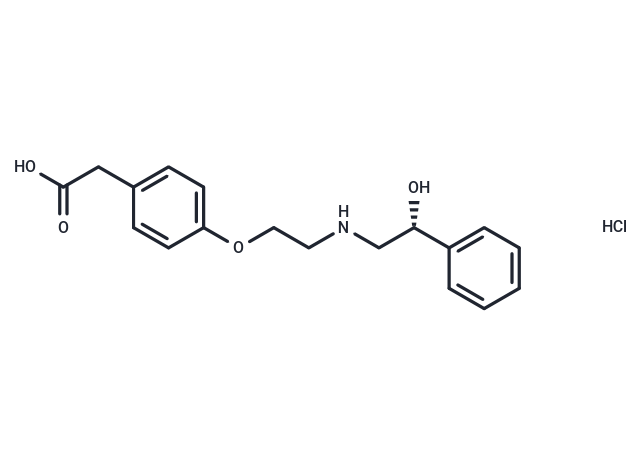Shopping Cart
- Remove All
 Your shopping cart is currently empty
Your shopping cart is currently empty

Talibegron hydrochloride (ZD2079 hydrochloride) is a β3 adrenergic receptor agonist with a pD2 of 3.72 on phenylephrine-preconstricted rat mesenteric artery. It relaxes rat mesenteric artery and isolated aorta in vitro, and inhibits ob gene expression and circulating leptin levels in lean mice in vivo.

| Pack Size | Price | Availability | Quantity |
|---|---|---|---|
| 1 mg | $30 | In Stock | |
| 5 mg | $65 | In Stock | |
| 10 mg | $81 | In Stock | |
| 25 mg | $179 | In Stock | |
| 50 mg | $260 | In Stock | |
| 100 mg | $355 | In Stock | |
| 200 mg | $485 | In Stock |
| Description | Talibegron hydrochloride (ZD2079 hydrochloride) is a β3 adrenergic receptor agonist with a pD2 of 3.72 on phenylephrine-preconstricted rat mesenteric artery. It relaxes rat mesenteric artery and isolated aorta in vitro, and inhibits ob gene expression and circulating leptin levels in lean mice in vivo. |
| In vitro | Talibegron hydrochloride ( 0.01-1000 μM) produces a concentration-dependent relaxation of phenylephrine-preconstricted isolated mesenteric arteries and causes full relaxation with 1 mM[1]. |
| In vivo | The β3-adrenoceptor agonist talibegron hydrochloride produced a concentration-dependent relaxation of phenylephrine-preconstricted isolated mesenteric arteries. The shape of the concentration–response curve of talibegron hydrochloride also suggests that this drug, which was studied up to 1 mm, causes full relaxation [3]. |
| Alias | ZD2079 hydrochloride, ZD 2079 hcl |
| Molecular Weight | 351.83 |
| Formula | C18H22ClNO4 |
| Cas No. | 178600-17-4 |
| Smiles | C(C(O)=O)C1=CC=C(OCCNC[C@H](O)C2=CC=CC=C2)C=C1.Cl |
| Relative Density. | no data available |
| Storage | Powder: -20°C for 3 years | In solvent: -80°C for 1 year | Shipping with blue ice. | |||||||||||||||||||||||||||||||||||
| Solubility Information | H2O: < 8.8 mg/mL DMSO: 50 mg/mL (142.11 mM) | |||||||||||||||||||||||||||||||||||
Solution Preparation Table | ||||||||||||||||||||||||||||||||||||
DMSO
| ||||||||||||||||||||||||||||||||||||

Copyright © 2015-2024 TargetMol Chemicals Inc. All Rights Reserved.